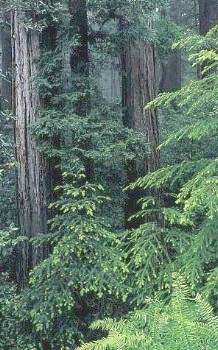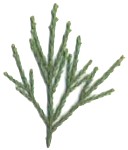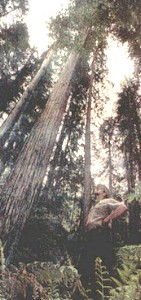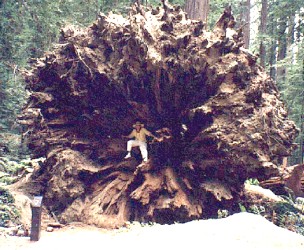 Sequoia sempervirens
Sequoia sempervirensThe Coast Redwood is a native of the west coast of the United States, a narrow 700-km-wide strip along the Pacific Ocean from central California to southern Oregon. Members of this species are the tallest trees in the world today, and also some of the oldest. Average mature trees which are several hundred years old usually stand from 60 to 75 metres tall (200 to 240 feet). Some Redwoods have been measured at more than 110 metres (360 feet). Coast Redwoods can live more than two thousand years, although the record is held by different tree. Redwoods are named for the colour of their wood. Like cedar, the high tannin content of the wood gives the trees resistance to fungus and insect infestations. Thick bark insulates them from periodic forest fires which destroy smaller trees. Redwood seedlings grow very rapidly, up to 30 cm (1 foot) per year, in good conditions. Temperatures where they grow are moderate all year, and heavy winter rains and dense summer fog provide the trees with the water they need. This climate was far more common in many continents in earlier eras; fossilized Redwoods have been discovered in many places around the world, some from as long ago as 160 million years. Coast redwood trees have two kinds of leaves. The top of the tree has small leaves, These are exposed to more wind and sunlight, and lose moisture rapidly ... that's why they're small. Leaves growing lower on the tree, however, are larger, flat, and tend to grow in clusters.   Upper leaves shown on left; lower leaves on right.  So which Coastal Redwood is the tallest tree in the world? That distinction belongs to a particular Redwood growing in the Montgomery Woods State Preserve, near Ukiah in California. It's named the Mendicino Tree, and it's shown in the photo on the left. Its height has been accurately measured at 112 metres, or 367.5 feet, which is five stories taller than the Statue of Liberty in New York! Its age has been estimated at about 1000 years, and the diameter of its trunk near the ground is 3.14 m (10.3 ft). The Park Service and the Save-the-Redwoods League are not releasing the precise location of the Mendocino Tree to the public, to prevent damage to the tree. So which Coastal Redwood is the tallest tree in the world? That distinction belongs to a particular Redwood growing in the Montgomery Woods State Preserve, near Ukiah in California. It's named the Mendicino Tree, and it's shown in the photo on the left. Its height has been accurately measured at 112 metres, or 367.5 feet, which is five stories taller than the Statue of Liberty in New York! Its age has been estimated at about 1000 years, and the diameter of its trunk near the ground is 3.14 m (10.3 ft). The Park Service and the Save-the-Redwoods League are not releasing the precise location of the Mendocino Tree to the public, to prevent damage to the tree.
 Although this Redwood is currently the tallest tree, it is not the tallest tree in history. The previous tallest Redwood was the 'Dyerville Giant', which was knocked over by a storm in 1991. You can see its stump in the photo at the right.
Although this Redwood is currently the tallest tree, it is not the tallest tree in history. The previous tallest Redwood was the 'Dyerville Giant', which was knocked over by a storm in 1991. You can see its stump in the photo at the right.Also, a Eucalyptus regnans tree in Australia is believed to have measured 143 m (470 ft); another Australian eucalyptus almost certainly had been over 150 m (492 ft) tall. Neither of these trees is still standing. |